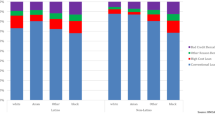Abstract
Many media and scholarly reports have focused on the subprime mortgage crisis and the resultant global financial meltdown. Most of the literature notes unequivocally that discrimination in the mortgage market has been, and remains, race-based and that it has damaged the African-American population disproportionately. This paper discusses the consequences of the subprime mortgage calamity and its negative impact on the Black community, women in general, and African-American women in particular. After controlling for individual, credit and housing characteristics, research shows that disparities in lending have persisted. Studies indicate that 63% of those given subprime mortgages qualified for prime mortgages. African-American females received the most high-cost loans and were over twice as likely to be given a subprime mortgage compared to White females. Moreover, African-American women were five times more likely to have received a subprime loan than similarly situated White males. Upper-income Black women were more often targeted for high-cost loans than lower-income women of color. As a result, the subprime mortgage crisis has precipitated an enormous loss of home equity and wealth among African-Americans that will affect generations to come.










Similar content being viewed by others
References
Avery RB, Brevoort KP, Canner GB. Higher-Priced Home Lending and the 2005 HMDA Data. Federal Reserve Bulletin; 2006.
Bradley J, Skillem P. 2000, January/February. Shelterforce Online. Retrieved February 8, 2011, from National Housing Institute: www.nhi.org/online/issues/109/bradley.html.
Brown CN. Intent and Empirics: Race to the Subprime. Marquette Law Review; 2010.
Bucks BK, Kennickell AB, Mach TL, Moore KB. Changes in U.S. family finances from 2004 to 2007: evidence from the survey of consumer finances. Washington, D.C: Federal Reserve; 2009.
Center for Responsible Lending Issue Brief. A national tragedy: HMDA data highlight homeownership setbacks for African Americans and Latinos. Durham: Center for Responsible Lending; 2010.
Chang M. Lifting as we climb: women of color, welth, and America's future. Oakland: Insight Center for Community Economic Development; 2010.
Consumers Union. Austin focus study. Austin; 2002.
Consumers Union. Minority subprime borrowers. Austin; 2002.
Consumers Union. Women in the subprime market. Austin; 2002.
Economic Policy Institute. Household wealth declines over the Great Recession. Retrieved February 11, 2011, from State of Working America: www.stateofworkingamerica.org/charts/view/213. 2010.
Federal Trade Commission. FTC, DOJ and HUD Announce Action to Combat Aubsive Lending Practices. Retrieved February 21, 2011, from Federal Trade Commission Protecting America's Consumers: www.ftc.gov/opa/2000/03/deltafunding.shtm. 2000, March 30.
Fishbein AJ, Woodall P. Women are prime targets for subprime lending: women are disproportionately represented in high-cost mortgage market. Washington, D.C.: Consumer Federation of America; 2006.
Goldstein I, Urevick-Ackelsberg D. Subprime lending, mortgage foreclosures and race: how far have we come and how far have we to go? Philadelphia: The Reinvestment Fund; 2008.
Hinnant-Bernard T, Crull SR. Subprime Lending and Reverse Redlining. Housing and Society, 169–186; 2004.
Hobbs F, Stoops N. Demographic trends in the 20th century. Washington, D.C.: U.S. Government Printing Office; 2002.
Jayasundera T, Silver J, Anacker K, Mantcheva D. Foreclosures in the nation's capital. Washington, D.C.: National Community Reinvestment Coalition; 2010.
Langley P. When "Credit Becomes Debt" in the subprime Crisis-Is there a Gender Dimension?; 2009
Leigh WA, Huff D. African Americans and homeownership: the subprime lending experience, 1995 to 2007. Washington, D.C.: Joint Center for Political and Economic Studies; 2007.
National Association of Realtors. Profile of home buyers and sellers; 2010.
National Community Reinvestment Coalition. Income is no shield against racial differences in lending II: a comparison of high-cost lending in America's metropolitan and rural areas. Washington, D.C.; 2008.
National Community Reinvestment Coalition; The Opportunity Agenda; Poverty and Race Research Action Council. Homeownership and wealth building impeded; 2006.
National Council of Negro Women and National Community Reinvestment Coalition. Income is no shield III: assessing the doubleburden: examining racial and gender disparities in mortgage lending; 2009.
Neale C. Subprime Loans and Bankruptcy: The memphis experience post-BAPCPA. American Bankruptcy Institute Journal 2009: 50–51.
Nothaft FE. 2010, January 19. Mortgage market update. Retrieved February 25, 2011, from Freddie Mac: www.freddiemac.com/speeches/pdf/nahb_ibs.pdf.
Oliver ML, Shapiro TM. 2008, September 22. Sub-Prime as a Black Catastrophe. Retrieved February 11, 2011, from The American Prospect: www.prospect.org/cs/articles?article=sub_prime_as_a_black_catastrophe.
Phillips S. The Subprime Crisis and African Americans. The review of black political economy 2010: 223–229.
Rivera A, Cotto-Escalera B, Desai A, Huezo J, Muhammad D. Foreclosed: state of the dream. Boston: United for a Fair Economy; 2008.
Rugh JS, Massey DS. Racial Segregation and the American Foreclosure Crisis. American Sociological Review 2010:629–651.
U.S. Census Bureau. Current PopulationSurvey/Housing VacancySurvey, Series H-111. Washington, D.C.; 2010.
Author information
Authors and Affiliations
Corresponding author
About this article
Cite this article
Phillips, S. The Subprime Mortgage Calamity and the African American Woman. Rev Black Polit Econ 39, 227–237 (2012). https://doi.org/10.1007/s12114-011-9107-1
Published:
Issue Date:
DOI: https://doi.org/10.1007/s12114-011-9107-1




